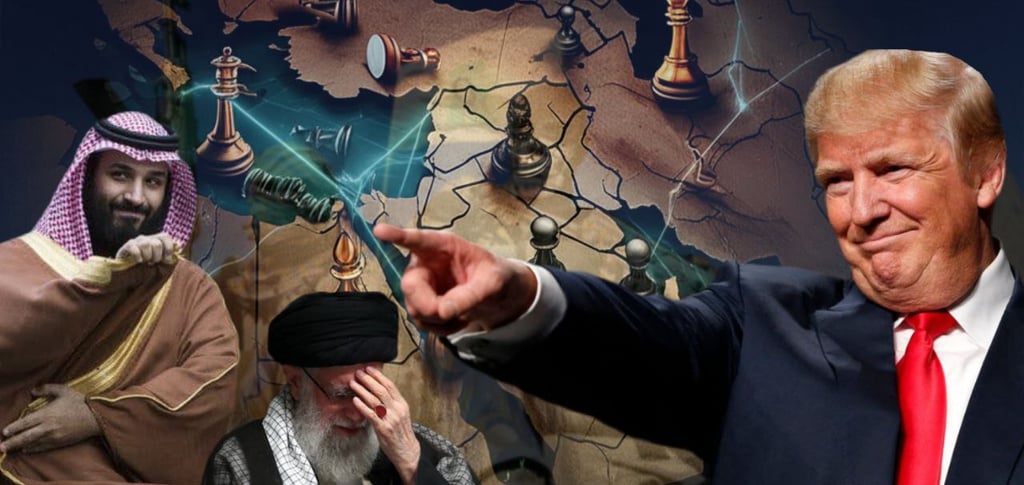The End of the Sectarian Game: America Abandons Minorities and Embraces the Sunnis
This article explores Saudi Arabia’s evolving role in the Middle East and how it aims to maintain regional balance without interfering in other nations' affairs.
Bilal Nour Al Deen
7/15/20253 min read


For decades, the United States pursued a Middle East strategy rooted in an old colonial logic: empowering minority groups. This policy—traced back to the Sykes-Picot Agreement—produced a series of long-term alliances with Lebanon’s Maronites, Syria’s Alawites and Kurds, and Iraq’s Kurds and Shiites after the fall of President Saddam Hussein’s regime. Yet rather than delivering stability, this approach yielded chronic crises. Now, that story appears to be reaching its end, as events have unfolded in ways that defy long-standing strategic expectations.
At the heart of this strategic shift—particularly following the October 7, 2023 “Al-Aqsa Flood” operation and the subsequent weakening of Iran and its allies—it became evident that the Middle East would not remain as it was. The collapse of Iraq after the U.S. invasion and its descent into sectarian strife, Lebanon’s political paralysis under Hezbollah’s control, and the persistent Kurdish tensions in Syria and Turkey have all reinforced a growing realization within American policymaking circles: minority-led governance breeds fertile ground for militias, foreign interventions, and extremist networks—developments that deeply concern the U.S. and its allies.
Today, Washington is charting a new course in the region—one oriented toward pragmatic alignment with Sunni-majority governments. This shift is not driven by ideology, democracy, or a moral commitment to regional populations, but rather by the recalibration of American interests around a single goal: securing long-term political stability to allow the U.S. to focus on containing China’s economic ascent.
Syria as a Model of the New Order
Syria serves as a clear illustration of this emerging shift. The U.S. now prioritizes Syrian stability, driven by mounting concerns over Damascus’s ongoing role as a hub for extremist networks that pose cross-border threats. The Alawite-dominated rule of Bashar al-Assad failed to achieve sustainable calm or foster national cohesion. At its core, the 2011 popular uprising was a reaction to decades of minority dominance over a Sunni majority—a reality that effectively shifted with the collapse of Assad’s regime by the end of 2024.
The fall of a minority-based regime is expected to help foster a renewed sense of political and social belonging among Syria’s Sunni majority, affirming their identity. This transformation may contribute to long-term internal stability and reduce the likelihood of sectarian violence. The change is also evident in recent American messaging toward the Kurds—historically reliant on U.S. support. Washington’s stance has become clearer: Kurdish entities must be integrated into unified national structures, encapsulated in the slogan: “One state, one people, one army.” The same applies to Turkey, where strategic tolerance for an insurgency led by the Kurdistan Workers’ Party (PKK) has vanished. The decision has been made: Kurdish arms must be surrendered, and state authority reasserted. The era of leveraging foreign support to pursue separatist or autonomous ambitions is over.
Furthermore, the new Syrian leadership—under President Ahmad al-Shara‘—is pursuing normalization with Israel, a step that may help neutralize a long-standing source of regional tension and enhance the security of Israel’s northeastern border. This is a strategic objective long sought by both Washington and Tel Aviv.
Saudi Arabia as a Key Partner
Iran has seen a regional decline, prompting countries in the region and the world to once again view Saudi Arabia as a key partner. Especially since the orientation of Crown Prince Mohammed bin Salman has transformed Riyadh into a decision-making capital in the Middle East. While Saudi Arabia shows cautious openness toward "peace" with Israel — a prospect still subject to complex calculations — any progress on this front could encourage other Arab and Islamic countries to follow suit.
This influence stems from Saudi Arabia’s ability to combine broad economic clout, strategic location, and effective outreach to wide segments of both the Arab and Islamic worlds.
The End of the Sectarian Divide
What is unfolding marks a decisive signal that models based on sectarian fragmentation and the re-division of Arab states into ethnic or sectarian entities are no longer viable. Though such approaches may appear as solutions to some, they merely reproduce conflict and plunge the region into recurring violence and chaos. For the West—and Israel in particular—a perpetually fragmented map means greater political and security burdens.
The picture is now clearer: while the West will not entirely abandon minority groups, it no longer sees them as a foundation for governance or as primary partners in regional management. What is emerging instead is a tacit consensus prioritizing full national sovereignty and legitimacy rooted in broad popular support—most notably among Sunnis. New regimes that align with this orientation will receive recognition and protection—not because they are ideal, but because they are viable. While much has changed, Israel’s role as the West’s foremost ally in the region remains vital and cannot be overlooked.
Contact me via email
SUBSCRIBE TO MY NEWSLETTER
hello@bilalnouraldeen.com
© 2025. All rights reserved.